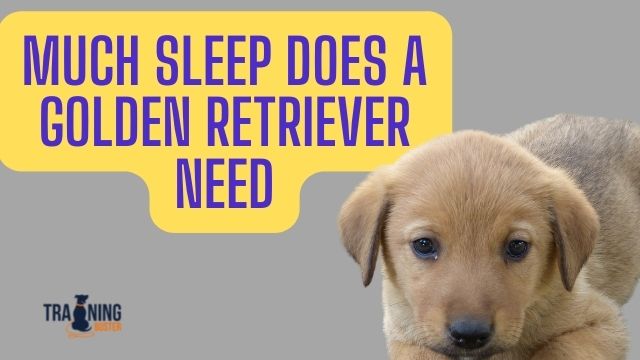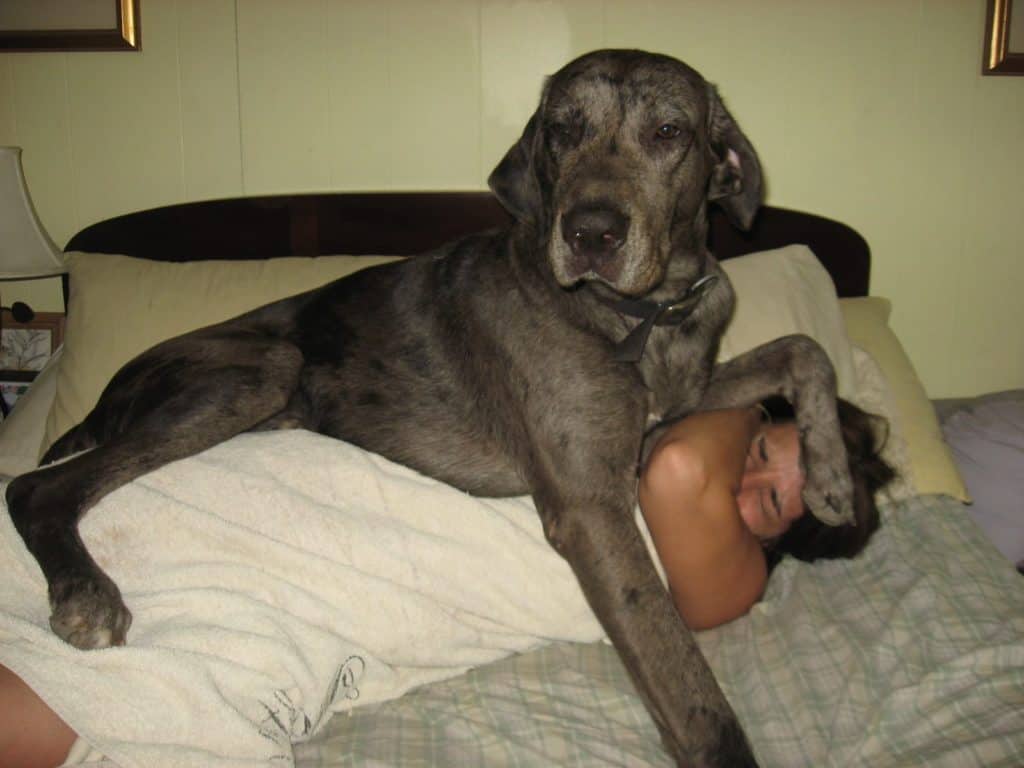Updated 10/01/2023
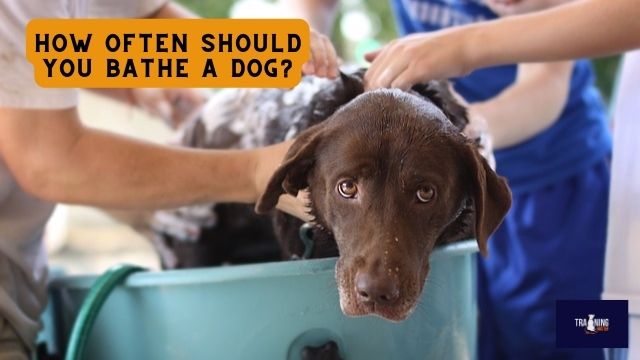
Want to learn how often you should bathe a Dog? Find out in this article. The quick answer is: It’s advised to bathe your dog at least once every three months. Long-haired dogs 6 to 12 Weeks. Short hair dogs you can wash as frequently as every other week with a gentle shampoo.
Splish splash, does your dog need a bath? Most humans shower once a day, but how often should you wash your dog? We’ll get down and dirty with the facts on how to keep your furry friend looking fresh and clean to ensure a happy, healthy pup.
How frequently should bathe my dog?
The frequency at which you should bathe your dog depends on several factors, including the breed of your dog, their coat type, and their lifestyle. Generally speaking, most dogs only need to be bathed every 3-4 weeks, but some breeds may need to be bathed more or less frequently.
For example, dogs with long or thick coats may require more frequent baths to keep their coats clean and free of tangles. On the other hand, dogs with short or smooth coats may only need to be bathed every 4-6 weeks.
Dogs with oily coats or that have skin conditions, may need to be bathed more frequently as well.
Additionally, the lifestyle of your dog also plays a big role, if your dog is an indoor pet with less exposure to dirt or mud, it may require less frequent baths than an outdoor dog that plays in the dirt every day.
Dogs that are regularly exposed to greasy or smelly substances, such as oil or chemicals, may also need more frequent baths.
It is important to remember that over-bathing your dog can dry out their skin and strip the natural oils from their coat.
It is always better to consult with your veterinarian or a professional groomer to establish a specific frequency that is tailored to your dog’s needs and lifestyle.
Things to consider when bathing your dog
Your dog’s Coat type?
Hairless breeds, such as the Chinese Crested and the Xoloitzcuintli, are actually quite care-intensive, and these breeds require weekly baths. At the other end of the spectrum are the long-coated breeds, such as the Maltese and the Collie.
Obviously, the more hair a dog has, the more work is involved, including the frequency of the bath. For dogs with medium-to-large coats, a bath could be needed from weekly to every 4 to 6 weeks, as long as the coat is properly maintained in-between baths.
But a breed such as the Puli, which is technically long-haired, is not bathed as often when corded.
So, what about dogs that fall somewhere in the middle? Thick or double coats on breeds such as Labrador Retrievers, Golden Retrievers, Siberian Huskies, etc., naturally insulate the dogs seasonally.
Overbathing could strip too much oil from the skin and disrupt this process. Using a product specifically for shedding will help avoid this.
How to bathe your dog
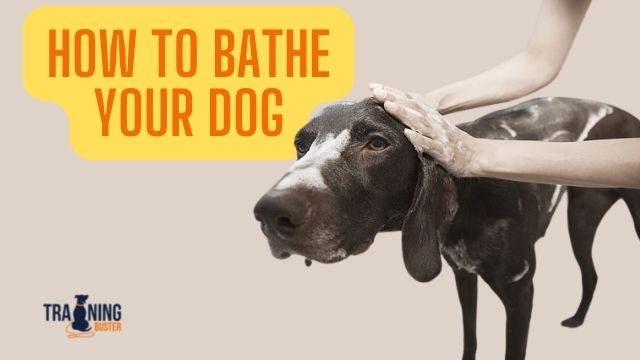
How do you bathe a dog correctly? It can be tricky trying to tame your pup in the tub while also washing them. Thanks to these tips, giving a dog a bath is easier than you think.
Try these simple steps to ensure you have a successful bath time with your furry friend. Buy shampoo and other supplies. Use a dog-specific shampoo that prevents suds from stinging their eyes. I use this shampoo. It works well for my dog.
I also recommend you use hypoallergenic and all-natural shampoo to reduce potential skin irritations and dryness. Have a rubber or non-stick bath mat. Find a cheap one like this on Amazon.
handy for the tub keeps them from slipping and sliding too much (both inside and outside the tub). Also, have cotton balls ready to gently place in their ears to block water out.
Brushing your dog after a bath
This step can easily get overlooked. After bath time, prep your pup by giving them a thorough brushing to get rid of tangles and excess hair.
Need a brush? You’re in luck, we’ve recommended the best dog brushes for you. Our favourite is here.
Tips to try before you bath a dog
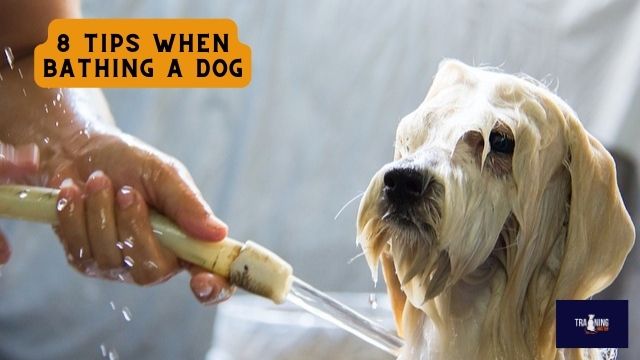
1 – Brush your dog’s coat: Before bathing your dog, it’s a good idea to brush out any tangles or matting in their coat. This will make it easier to lather and rinse your dog and will help prevent any discomfort they might experience during the bath.
2 – Protect your dog’s ears: Dogs have sensitive ears that can be easily irritated by water. Before bathing your dog, use cotton balls or a specialized ear cleaner to protect their ears and prevent water from entering.
3 – Trim your dog’s nails: Long nails can become snagged or torn during a bath, so it’s a good idea to trim them down before getting your dog wet.
4 – Gather all the necessary supplies: Make sure you have everything you need for the bath, including a mild dog shampoo, a cup for rinsing, a towel for drying, and any brushes or combs you need to style your dog’s coat after the bath.
5 – Test the water temperature: Before getting your dog in the water, test the temperature to make sure it’s not too hot or too cold. It should be warm, but not hot.
6 – Get your dog used to the sound and sensation of running water. This will help them to be more relaxed during the bath.
7 – Make sure you have a secure and safe place to hold your dog while bathing. You should also be sure that the place is non-slip, to avoid any accidents during the process.
8 – Reward your dog after the bath, with praise, treats or toys. Positive reinforcement will help your dog to be more comfortable with this process, and it will make the bonding stronger.
Once your pup is wet, you’ll have your hands full so having everything you need nearby is necessary.
Set aside a clean towel, a cup for rinsing (if need be) and treats for afterwards (or during for good behaviour).
Never leave a dog unattended in the tub, and if you’re outside, make sure your dog is contained or on a leash.
Check the water temperature when bathing your dog.
“Can I bathe my dog in cold water?” is common question dog owners ask. Lukewarm to slightly warm water is ideal. Never use hot water as it can burn their skin. Think of what would be good for a newborn baby or a small child. Not too hot, not too cold.
Additionally, Use your wrist or elbow to test the water temperature.
Can you use human shampoo on dogs?
No. though you’d think that human shampoo and doggy shampoo would be pretty similar, it turns out that the formulation of shampoo made for humans actually disrupts your pooch’s acid mantle.
This opens your dog up to more viruses, parasites, and bacteria. The human shampoo also makes your dog’s skin feel flaky and dry, which leads to your dog scratching themselves more in their discomfort. This further increases the risk of your dog becoming ill.
So, what are you do to when your dog has decided to roll in something particularly nasty and you don’t have anything appropriate in to scrub them with? Well, there are a few gentle home alternatives to standard dog shampoo that will leave your pooch fragrant and gleaming!
A little diluted dish soap can help get a lather foaming and break down anything particularly stinky, while baking soda or cornstarch can do a similar job, too. You can also use baby shampoo or gentle wipes on your dog’s fur, too – handy when you’re out and about.
Can I use a human conditioner on my dog?
If human shampoo is strictly off-limits to your pooch, what about conditioner? Some dogs have long fur that can easily get tangled – couldn’t you just use your own conditioner if you run out of theirs?
No. dogs have a significantly different pH level to a humans. They also have more sensitive skin and different common allergens, as well as something called the acid mantle – a unique thin layer of skin that better protects their coat.
So, your dog needs a completely different conditioner to you if you want to keep their fur hydrated, gleaming, and in peak condition.
If your pooch has long, luscious locks in need of some TLC, why not try Buddy Wash Original Lavender and Mint Conditioner? Not only will this conditioner revitalize and moisturize your pooch’s hair with its gentle
How often should you bath a dog in the winter?
In the winter, dogs generally need fewer baths due to the dry, cold weather. The reduced humidity and cold temperatures make it less likely for dogs to get dirty or smelly as quickly as in the warmer months.
As a general rule, dogs can go about 6-8 weeks between baths during the winter. If your dog spends a lot of time outdoors in the winter, it may be necessary to give them a bath more frequently to remove salt, snow and dirt.
However, this is case dependent and it is better to consult with your veterinarian or a professional groomer to establish a specific frequency that is tailored to your dog’s needs and lifestyle.
Why does my dog still stink after a bath?
1 – Not using the right shampoo: If you’re not using a shampoo that’s formulated specifically for dogs, it may not be effective at eliminating odours.
Some human shampoos or baby shampoos can be too harsh for dogs and will strip the natural oils from their skin which can cause dryness, discomfort, or even make the smell worse.
2 – Not rinsing thoroughly: If you don’t rinse your dog thoroughly after bathing, soap residue can be left behind, which can cause skin irritation and lead to a strong odour.
3 – Ear infections: Dogs‘ ears are more prone to infections than humans’, especially breeds with droopy ears, the moisture inside their ears is a perfect environment for bacteria and yeast growth, and it can cause a foul odour.
4 – Dental problems: Dogs with dental issues such as tartar buildup or infected gums may have bad breath that can contribute to an overall bad smell.
5 – Skin conditions: Dogs can develop skin conditions such as yeast or bacterial infections that can cause a strong odour. These conditions often require treatment with medicated shampoos or antibiotics.
6 – Anal glands: Some dogs’ anal glands may not empty properly leading to a secretion of a very pungent odour. This is a condition that should be treated by a vet.
It’s always best to consult with your veterinarian if your dog is still having an odour after a bath, they can help you to determine the cause of the problem and recommend the best course of treatment.
Towel or blow-dry your dog?
Covering your pup in a towel retains heat and also lessens the chances of them shaking water all over you (and your house). If it’s cold, or your dog has long hair that takes longer to dry, you might consider using a dog blow dryer to speed up the process.
Bath training tips
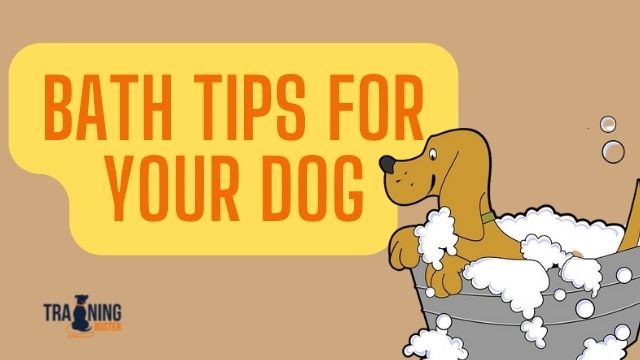
So, what can you do to make bathing easier for your pooch? Well, the first step is to figure out exactly what it is they dislike about the bath.
Is it the sliding around on the floor? If so, try a bath mat or hand towel with your pooch. Or is it the temperature?
Many pooches dislike the heat that we humans adore. On certain sensitive areas, like their nose, the water can be unbearable. So, try turning down the heat to see if this will help.
If it’s hot out, why not bathe your pooch outside? If you have a paddling pool out in the yard anyway, chuck your dog in for a fun way to cool them down.
Make sure the hose isn’t on too strong if you rinse them, and don’t fill your pool all the way up so that the water can quickly get to a comfortable temperature.
Why not bring your dog into the shower? Sure, there’s that traditional image of the dog in the tub. But for many people, bathing your dog in the shower makes a convenient option.
With the shower door closed, your pup can shake as much as they like without the need to practically hose down the entire bathroom afterwards!
Or maybe the scent of the shampoo is what’s bothering your dog? Modern canine shampoos have gorgeous scents. But, as we all know, pooches have extremely sensitive noses, some breeds more than others.
So, it’s not surprising that your dog may dislike heavily scented shampoos. If you think this may be the problem, try picking up an unscented shampoo for your dog.
Some dogs are even fearful of the tub. Whether it’s the sound, sight, size, or something that happened in their past, many dogs just detest bathtime and need to be slowly desensitized to the bath. To do this at home, you could try rewarding your pooch with their favorite treats.
Toss your dog one of their favourite treats just for coming into the bathroom. Try this several times until you notice that your dog is calmer in the room. Then, try throwing a treat into the tub. Your dog may jump in after it, or you can lift them in.
When your pooch is calmly in the tub, try gently turning the water on. You can then try more and more force until your dog is now comfortable having a bath!
If your dog is very fearful of the bath, try contacting a local positive-reinforcement trainer.
Have fun bathing your dog
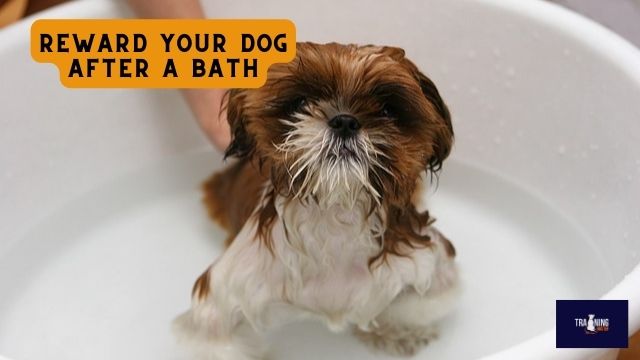
Are you trying to figure out how to give a dog a bath that hates baths? Make it enjoyable! Bathing can be a bonding experience for both you and your dog.
Take baby (or puppy) steps introducing them to water and working up to a full bath. Don’t take the plunge right away.
Be patient and gentle. If the dog senses you are stressed out they will be too. Make sure you reward with treats and show lots of love and affection.

